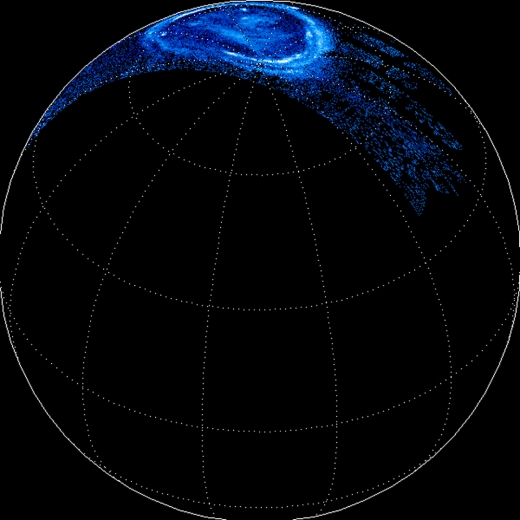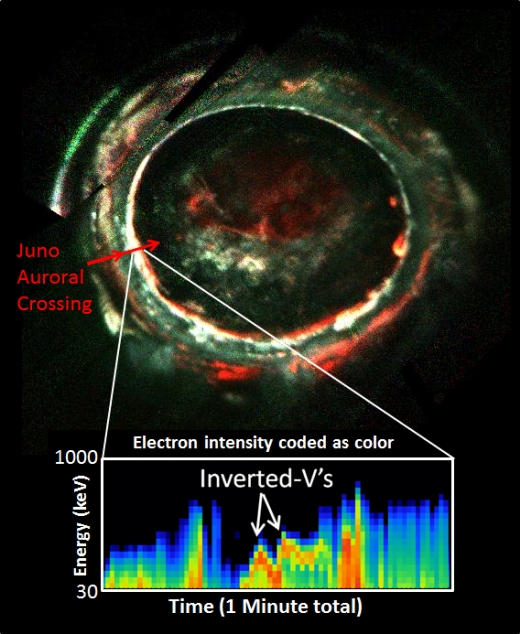While we track hurricane Irma and its path of devastation in the Caribbean, another kind of storm is affecting the skies over more northerly areas. A strong geomagnetic storm watch continues in effect, making it possible that the aurora borealis — northern lights — will be visible further south than usual, in Scotland and southern Scandinavia but perhaps into the continental United States as well, while the aurora australis could be active for those in the more southerly latitudes below the equator. All of this is due to sunspot AR2673, which is the source of a flare and coronal mass ejection hurled out of the Sun on Monday.
I’ve seen the northern lights in Iceland on one spectacular October night, but only once — in Iowa, in 1970 — have I seen them in the US. The phenomenon results from electrons accelerated as they encounter the Earth’s magnetosphere, following the magnetic field lines to the polar regions, where from 500 kilometers down to 80 kilometers up, they collide with oxygen and nitrogen in the atmosphere. People have described the resulting effect as a rippling curtain, sometimes white, sometimes in shifting colors, which is what I saw in Iceland.
The segue here is to the Juno spacecraft, which is giving us data about the powerful energies swirling around Jupiter’s polar regions, contributing to that planet’s own auroral patterns. Juno made its seventh science flyby on September 1 at 21:49 UTC, with perijove (the point in its orbit when it is closest to the center of the planet) at about 3500 kilometers above the cloud tops.
Juno’s ultraviolet spectrograph and energetic-particle detector instruments are showing us how powerful electrical potentials aligned with the planet’s magnetic field are accelerating electrons into the atmosphere at energies of up to 400,000 volts. This turns out to be 10 to 30 times higher than the largest auroral potentials we’ve ever observed in Earth’s auroras.

Image: This is a reconstructed view of Jupiter’s northern lights through the filters of Juno’s ultraviolet imaging spectrometer (UVS) instrument on Dec. 11, 2016, as the Juno spacecraft approached Jupiter, passed over its poles, and plunged towards the equator. Such measurements present a real challenge for the spacecraft’s science instruments: Juno flies over Jupiter’s poles at 50 kilometers per second, speeding past auroral forms in a matter of seconds. Credit: NASA/JPL-Caltech/SwRI.
Given that Jupiter was already known to generate the most spectacular auroras in the Solar System, this comes as no surprise. What does raise the eyebrows is that despite the size of these electrical potentials, they do not appear to be the source of the most intense auroras, as they are at the Earth. Barry Mauk (Johns Hopkins University Applied Physics Laboratory) leads the team handling the spacecraft’s Jupiter energetic particle detector Instrument:
“At Jupiter, the brightest auroras are caused by some kind of turbulent acceleration process that we do not understand very well,” said Mauk. “There are hints in our latest data indicating that as the power density of the auroral generation becomes stronger and stronger, the process becomes unstable and a new acceleration process takes over. But we’ll have to keep looking at the data.”

Image: This image, created with data from Juno’s ultraviolet imaging spectrometer, marks the path of Juno’s readings of Jupiter’s auroras, highlighting the electron measurements that show the discovery of the so-called discrete auroral acceleration processes indicated by the “inverted Vs” in the lower panel. This signature points to powerful magnetic-field-aligned electric potentials that accelerate electrons toward the atmosphere to energies that are far greater than what drive the most intense aurora at Earth. Scientists are looking into why the same processes are not the main factor in Jupiter’s most powerful auroras. Credit: NASA/JPL-Caltech/SwRI.
We can take advantage of the extreme conditions at Jupiter to study what happens when charged particles are accelerated to the immense energies on display in Juno’s data, which gives us insights into how distant astrophysical systems operate. But understanding Jupiter’s radiation belts is likewise a key challenge for the near-term, because spacecraft operating in the vicinity of the giant planet, as we want to do when we examine its Galilean moons, face the problem of engineering solutions to withstand these radiation levels.
Space weather, in other words, turns out to be valuable for the lessons it provides on protecting instruments and future astronauts in conditions as harsh as these. So if you do see the aurora borealis or australis tonight, or if you did last night, keep in mind that the comparative study of Earth and Jupiter’s magnetosphere seems to be showing new processes at work at the highest energy levels. That’s all to the good for planetary physics and the health of future missions.
The paper is Mauk et al., “Discrete and broadband electron acceleration in Jupiter’s powerful aurora,” Nature 549 (7 September 2017), pp. 66-69 (abstract).



I have some pretty sensitive GPS equipment running that is measuring the total electron content of the local ionosphere. CMEs can induce significant fluctuations and so this recent solar activity in AR2673 will be interesting to follow. I’ll be processing data later today. I haven’t yet had the pleasure of witnessing an aurora first hand, so I have that to look forward to.
The Pioneer 10 and 11 images of these moons were better:
https://www.nasa.gov/image-feature/jpl/pia21968/juno-observes-jupiter-io-and-Europa
Still very disappointed that Juno won’t be taking close enough images of the Jovian clouds to search for floaters. Carl Sagan did say that the Voyager image resolutions may be good enough for those giant alien gasbags to be visible.
Juno Finds that Jupiter’s Gravitational Field is “Askew”
Article written: 26 Oct 2017
by Matt Williams
Since it established orbit around Jupiter in July of 2016, the Juno mission has been sending back vital information about the gas giant’s atmosphere, magnetic field and weather patterns. With every passing orbit – known as perijoves, which take place every 53 days – the probe has revealed more interesting things about Jupiter, which scientists will rely on to learn more about its formation and evolution.
During its latest pass, the probe managed to provide the most detailed look to date of the planet’s interior. In so doing, it learned that Jupiter’s powerful magnetic field is askew, with different patterns in its northern and southern hemispheres.
These findings were shared on Wednesday. Oct. 18th, at the 48th Meeting of the American Astronomical Society’s Division of Planetary Sciences in Provo, Utah.
https://www.universetoday.com/137627/juno-finds-jupiters-gravitational-field-askew/
Even Van Gogh would be impressed with Jupiter as seen by Juno:
http://earthsky.org/space/images-junos-8th-science-flyby-of-jupiter?mc_cid=859e237850&mc_eid=719b90ecbf
And to think that the science team actually didn’t want to deal with a camera for Juno. Did the last 50 years of planetary exploration mean nothing to them when it comes to how important images are, especially for garnering public support and education?
I know most scientists are not and cannot be Carl Sagan, but they still need to work on their social skills when it comes to enlightening the masses. Otherwise they can forget exploring space.
Juno Isn’t Exactly Where it’s Supposed To Be. The Flyby Anomaly is Back, But Why Does it Happen?
Article written: 1 December 2017
by Matt Williams
In the early 1960s, scientists developed the gravity-assist method, where a spacecraft would conduct a flyby of a major body in order to increase its speed. Many notable missions have used this technique, including the Pioneer, Voyager, Galileo, Cassini, and New Horizons missions. In the course of many of these flybys, scientists have noted an anomaly where the increase in the spacecraft’s speed did not accord with orbital models.
This has come to be known as the “flyby anomaly”, which has endured despite decades of study and resisted all previous attempts at explanation. To address this, a team of researchers from the University Institute of Multidisciplinary Mathematics at the Universitat Politecnica de Valencia have developed a new orbital model based on the maneuvers conducted by the Juno probe.
The study, which recently appeared online under the title “A Possible Flyby Anomaly for Juno at Jupiter“, was conducted by Luis Acedo, Pedro Piqueras and Jose A. Morano. Together, they examined the possible causes of the so-called “flyby anomaly” using the perijove orbit of the Juno probe. Based on Juno’s many pole-to-pole orbits, they not only determined that it too experienced an anomaly, but offered a possible explanation for this.
https://www.universetoday.com/137984/juno-isnt-exactly-supposed-flyby-anomaly-back-happen/
The article online here:
https://arxiv.org/pdf/1711.08893.pdf
SOFIA Makes Jupiter Observations Previously Only Possible from Space
https://www.nasa.gov/feature/nasa-flying-observatory-makes-observations-of-jupiter-previously-only-possible-from-space